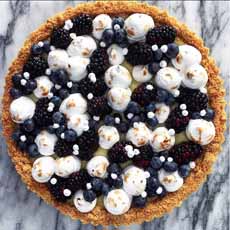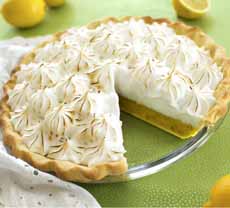|
Fun and beauty combine in this blueberry-blackberry pie, from Kindred Restaurant in Davidson, North Carolina.
Just looking at the cuisine at Kindred makes us want to head to the charming lakeside college town for a week’s vacation of dining and enjoying the view.
For now, we’ll have to content ourself with copying the pie, which is pretty easy to follow:
Graham cracker crust
Custard or lemon meringue base
Topping of blueberries and blackberries (the textural differences add to the charm, and you can substitute strawberries and raspberries)
Soft meringue and a piping bag
You don’t need piping skills: The whole idea is different sizes of meringues.
We’ll try a light garnish, too: a bit of lemon zest or a chiffonade of basil.
THE DIFFERENT TYPES OF MERINGUE
There are three basic types of meringue: French, Italian and Swiss. A sub-tip of the day is to try them all, and decide which you prefer.
Here are meringue details.
THE HISTORY OF MERINGUE TOPPING & COOKIES
Some sources say that that meringue (muh-RANG) was invented in the Swiss village of Meiringen in the 18th century, and subsequently improved by an Italian chef named Gasparini.
Not all experts agree: The Oxford English Dictionary, for example, states that the French word is of unknown* origin. Meringue wasn’t invented in France.
Even Larousse Gastronomique, The New American Edition of the World’s Greatest Culinary Encyclopedia, acknowledges the Swiss possibility along with:
Poland: Created by an unknown chef in the court of King Stanislas I Leszcy?ski of Poland, who later became Duke of Lorraine. While this theory says that “meringue” derives from the Polish marzynka, we were unable to find that word in a Polish dictionary.
England: The earliest written recipe for a baked “beaten-egg-white-and-sugar confection” is a handwritten recipe from 1604 called white bisket bread, from Lady Elinor Poole Fettiplace (1570-c.1647) of Oxfordshire, which later appeared in her book, “Elinor Fettiplace’s Receipt Book — Elizabethan Country House Cooking.”
In a later generation, Lady Rachel Fane (c. 1612–1680) of Kent has a recipe called “pets.” Slowly-baked meringues are still referred to as pets in the Loire region of France (the reference appears to be their light fluffiness, perhaps like a bunny or kitten, or for pétillant [sparkling] wine).
The first evidence of the confection called meringue first appeared in print in Chef François Massialot’s seminal 1691 cookbook, available in translation as . The English first saw the word in 1706, in an English translation of Massialot’s book.
|
|

[1] Blueberry and blackberry pie with meringue garnish, at Kindred restaurant in North Carolina.

[2] One of the benefits of dots of meringue (photo #1) is that you don’t need the skill to pipe evenly (photo by Hannah Kaminsky, Bittersweet Blog).

[3] Meringues can be baked into hard cookies or pavlovas, or cooked or torched briefly as a soft topping (here’s the recipe from Raw Spice Bar).
|
Until the early 19th century, meringues cooked in the oven were shaped between two large spoons. Meringue piped through a pastry bag was introduced by the great French chef Marie-Antoine Carême (1784-1833—he preferred to be called Antonin), the founder of the concept of haute cuisine and the four mother sauces. He invented mayonnaise and many other recipes, including charlotte Russe, coeur à la crème, croquembouche, éclairs, mille-feuille and other iconic French recipes.
No one can find a historical derivation of the word “meringue*,” but the latest suggestion is that it comes from Middle Dutch meringue, meaning light evening meal—possibly from the Latin merenda, “light evening meal.”
Our personal favorite is the Middle Low German “meringe,” from mern, “to dip bread in wine.” Who wouldn’t like to dip a meringue in a glass of wine?
________________
*Contenders from include 1700 on include, from the Walloon dialect, maringue, shepherd’s loaf; marinde, food for the town of Meiringen (Bern canton, Switzerland). While they have a few letters in common with meringue, evidence for both is completely lacking. A source that makes more sense is the Latin merenda, the feminine gerund of merere, to merit. Who doesn’t merit a delicious confection? But as our mother often said: “Who cares; let’s eat!”
|





